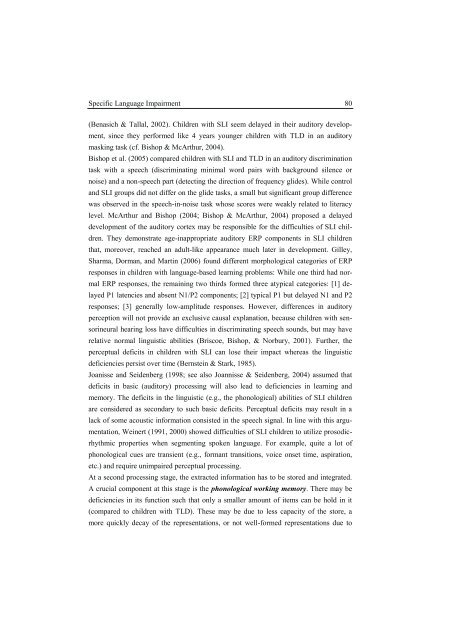Neural Correlates of Processing Syntax in Music and ... - PubMan
Neural Correlates of Processing Syntax in Music and ... - PubMan
Neural Correlates of Processing Syntax in Music and ... - PubMan
Create successful ePaper yourself
Turn your PDF publications into a flip-book with our unique Google optimized e-Paper software.
Specific Language Impairment 80<br />
(Benasich & Tallal, 2002). Children with SLI seem delayed <strong>in</strong> their auditory development,<br />
s<strong>in</strong>ce they performed like 4 years younger children with TLD <strong>in</strong> an auditory<br />
mask<strong>in</strong>g task (cf. Bishop & McArthur, 2004).<br />
Bishop et al. (2005) compared children with SLI <strong>and</strong> TLD <strong>in</strong> an auditory discrim<strong>in</strong>ation<br />
task with a speech (discrim<strong>in</strong>at<strong>in</strong>g m<strong>in</strong>imal word pairs with background silence or<br />
noise) <strong>and</strong> a non-speech part (detect<strong>in</strong>g the direction <strong>of</strong> frequency glides). While control<br />
<strong>and</strong> SLI groups did not differ on the glide tasks, a small but significant group difference<br />
was observed <strong>in</strong> the speech-<strong>in</strong>-noise task whose scores were weakly related to literacy<br />
level. McArthur <strong>and</strong> Bishop (2004; Bishop & McArthur, 2004) proposed a delayed<br />
development <strong>of</strong> the auditory cortex may be responsible for the difficulties <strong>of</strong> SLI children.<br />
They demonstrate age-<strong>in</strong>appropriate auditory ERP components <strong>in</strong> SLI children<br />
that, moreover, reached an adult-like appearance much later <strong>in</strong> development. Gilley,<br />
Sharma, Dorman, <strong>and</strong> Mart<strong>in</strong> (2006) found different morphological categories <strong>of</strong> ERP<br />
responses <strong>in</strong> children with language-based learn<strong>in</strong>g problems: While one third had normal<br />
ERP responses, the rema<strong>in</strong><strong>in</strong>g two thirds formed three atypical categories: [1] delayed<br />
P1 latencies <strong>and</strong> absent N1/P2 components; [2] typical P1 but delayed N1 <strong>and</strong> P2<br />
responses; [3] generally low-amplitude responses. However, differences <strong>in</strong> auditory<br />
perception will not provide an exclusive causal explanation, because children with sensor<strong>in</strong>eural<br />
hear<strong>in</strong>g loss have difficulties <strong>in</strong> discrim<strong>in</strong>at<strong>in</strong>g speech sounds, but may have<br />
relative normal l<strong>in</strong>guistic abilities (Briscoe, Bishop, & Norbury, 2001). Further, the<br />
perceptual deficits <strong>in</strong> children with SLI can lose their impact whereas the l<strong>in</strong>guistic<br />
deficiencies persist over time (Bernste<strong>in</strong> & Stark, 1985).<br />
Joanisse <strong>and</strong> Seidenberg (1998; see also Joannisse & Seidenberg, 2004) assumed that<br />
deficits <strong>in</strong> basic (auditory) process<strong>in</strong>g will also lead to deficiencies <strong>in</strong> learn<strong>in</strong>g <strong>and</strong><br />
memory. The deficits <strong>in</strong> the l<strong>in</strong>guistic (e.g., the phonological) abilities <strong>of</strong> SLI children<br />
are considered as secondary to such basic deficits. Perceptual deficits may result <strong>in</strong> a<br />
lack <strong>of</strong> some acoustic <strong>in</strong>formation consisted <strong>in</strong> the speech signal. In l<strong>in</strong>e with this argumentation,<br />
We<strong>in</strong>ert (1991, 2000) showed difficulties <strong>of</strong> SLI children to utilize prosodicrhythmic<br />
properties when segment<strong>in</strong>g spoken language. For example, quite a lot <strong>of</strong><br />
phonological cues are transient (e.g., formant transitions, voice onset time, aspiration,<br />
etc.) <strong>and</strong> require unimpaired perceptual process<strong>in</strong>g.<br />
At a second process<strong>in</strong>g stage, the extracted <strong>in</strong>formation has to be stored <strong>and</strong> <strong>in</strong>tegrated.<br />
A crucial component at this stage is the phonological work<strong>in</strong>g memory. There may be<br />
deficiencies <strong>in</strong> its function such that only a smaller amount <strong>of</strong> items can be hold <strong>in</strong> it<br />
(compared to children with TLD). These may be due to less capacity <strong>of</strong> the store, a<br />
more quickly decay <strong>of</strong> the representations, or not well-formed representations due to












